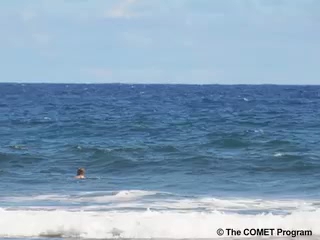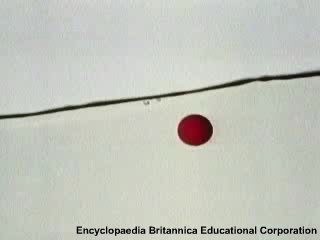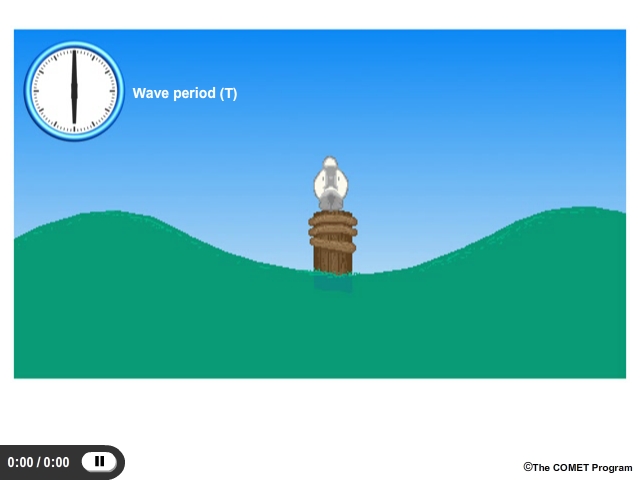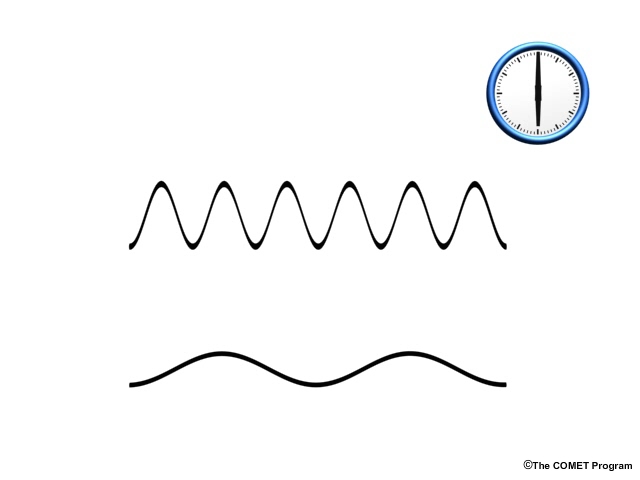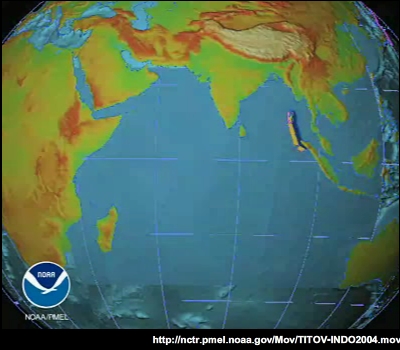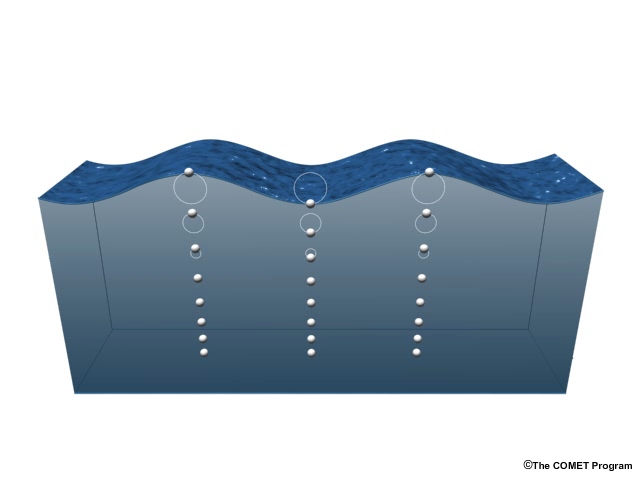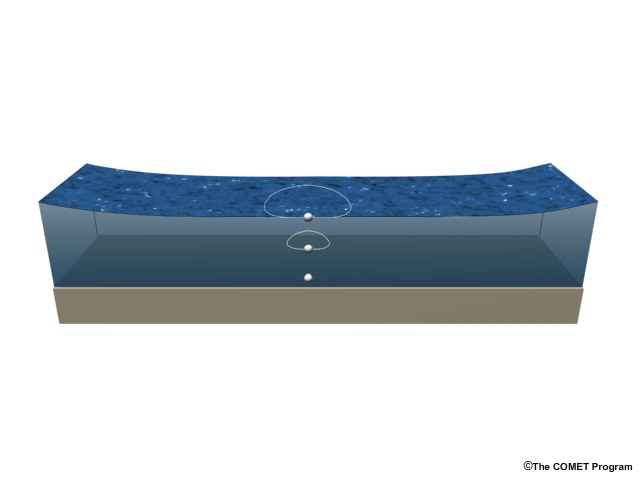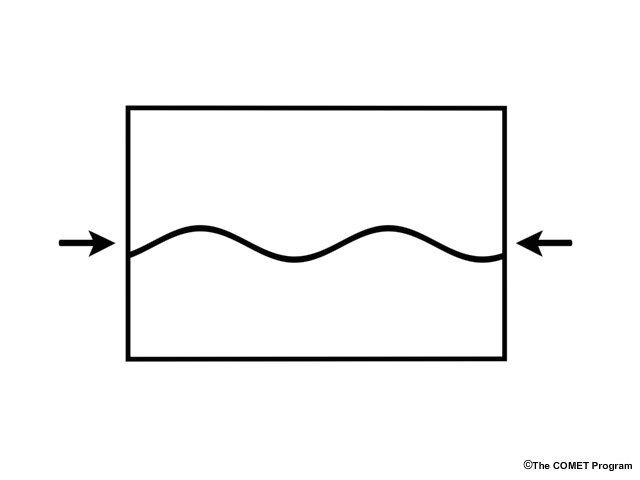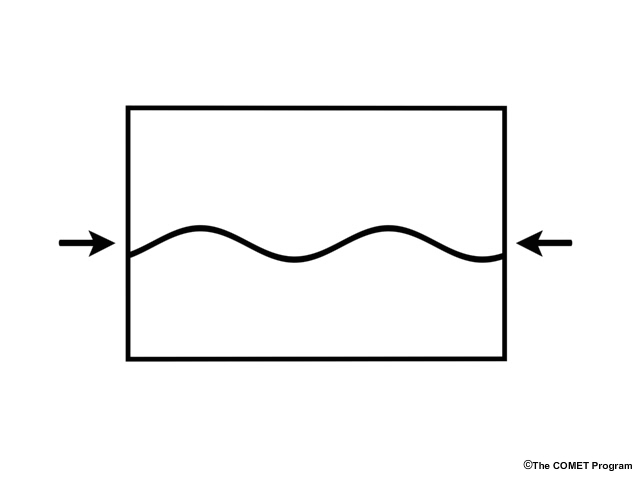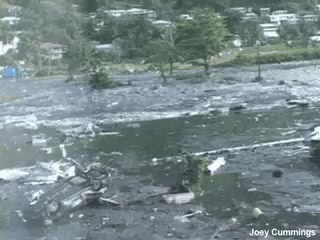Produced by The COMET® Program
Waves Everywhere
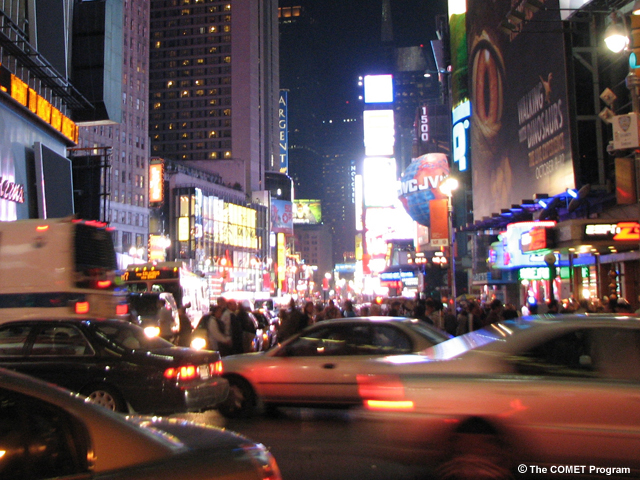
Waves travel in and out of your life every day, even if you live nowhere near the ocean. Light travels in waves, as do other forms of energy that you can't see, like radio waves and sound waves.

But the waves you are probably most familiar with are water waves. As different as they are, all these waves have similar properties.
Waves Transmit Energy
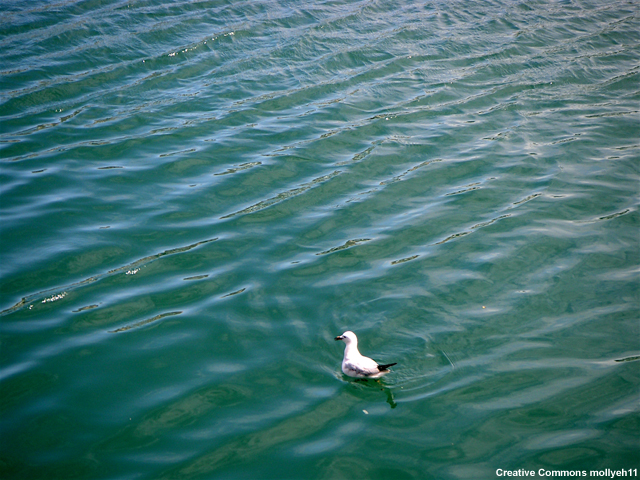
One interesting property of waves is that they transmit energy, but move matter very little distance during this process. For example, sound waves travel through the air without making wind, and water waves move through water without necessarily moving it forward.
If you look at a swimmer floating on the water out past where the waves break at the shore, you can see that even though waves move underneath him, the swimmer bobs up and down but stays pretty much in the same place.
If we could see the individual water particles beneath the wave, we would observe the same thing. The particles move in small circles as the wave passes, but don't travel very far from their starting points. They are affected by the passing energy, but they aren't pushed very far along with it.
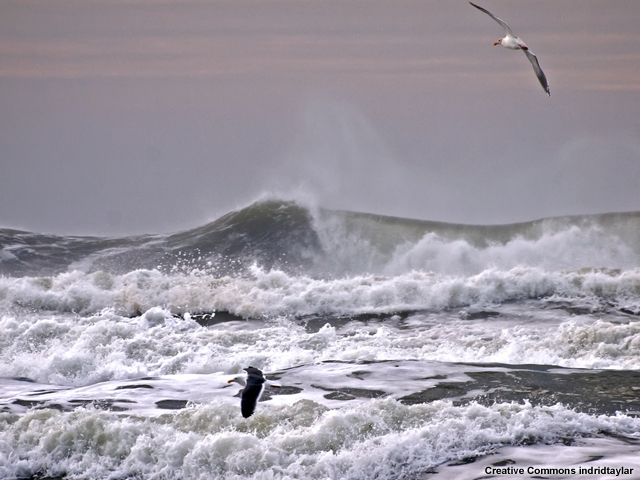
Until the waves reach the shore, that is. In this lesson, you will explore the characteristics of water waves and also learn why tsunamis are unusual, but still follow the same basic rules as regular ocean waves. Let's look at some of these rules.
Wave Properties
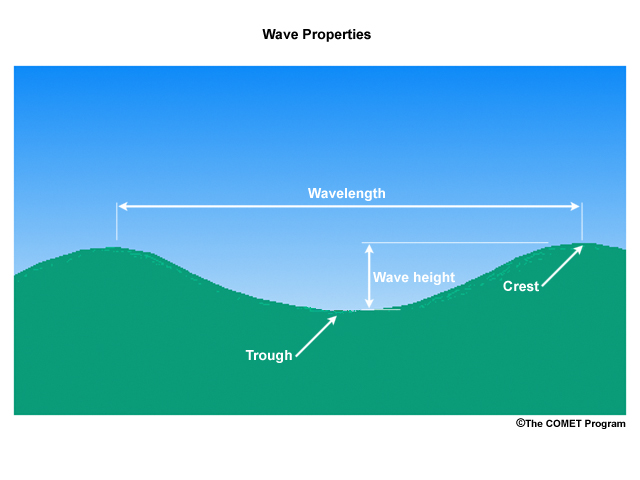
Here is a diagram of a simple wave. In it you can see that waves have high points, called crests, and low points, called troughs. The horizontal distance between two adjacent crests or troughs is called the wavelength. The vertical distance between the top of a crest and the bottom of the trough immediately in front of or behind it is called the wave height . Wavelength and height are just two of the ways that waves can differ from one another.
Now imagine you start a stopwatch when a trough passes and stop it when the next trough arrives, signaling that a complete wave has passed. The time it takes a complete wave to pass a point is the wave period.
Wave Speed
Because waves can have different wavelengths, period alone doesn't tell us the speed or velocity of a wave. But we can use the wavelength and period to calculate wave speed using the equation:
Wavelength (L) / Wave Period (T) = Wave Speed
The two waves shown here have equal wave periods of 10 seconds, but they are traveling at different speeds because their wavelengths are so different. They also differ greatly in their wave heights.
The bottom wave has a wavelength three times larger than the top wave. Because the waves have the same wave period, we know that the bottom wave must be traveling three times faster.
Wave Generation
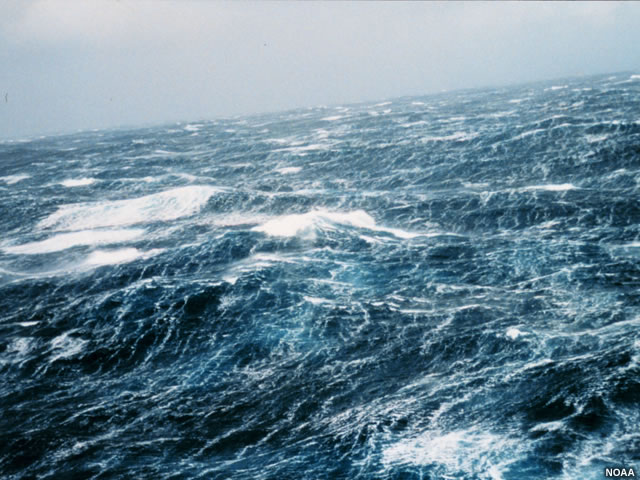
Most waves in water are created by wind blowing across the surface. The stronger the wind and the longer it lasts, the higher the waves will be.
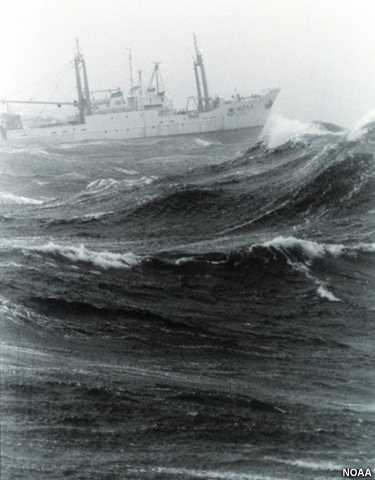
Storms at sea can make mighty waves this way, sometimes 15 meters, or 50 feet, high or even greater. Wind waves at sea often have wavelengths from 10 to several hundred meters, and average periods of 10 to 30 seconds.
But waves can also be created from below the ocean instead of from winds above. For example, the largest tsunami waves are created by earthquakes that can make many square kilometers of sea floor rise up. These waves are quite different from wind waves. They can have wavelengths of more than one hundred kilometers and periods of 10 to 60 minutes or even longer—off the chart by wind wave standards.
Comparing Wind Waves and Tsunamis
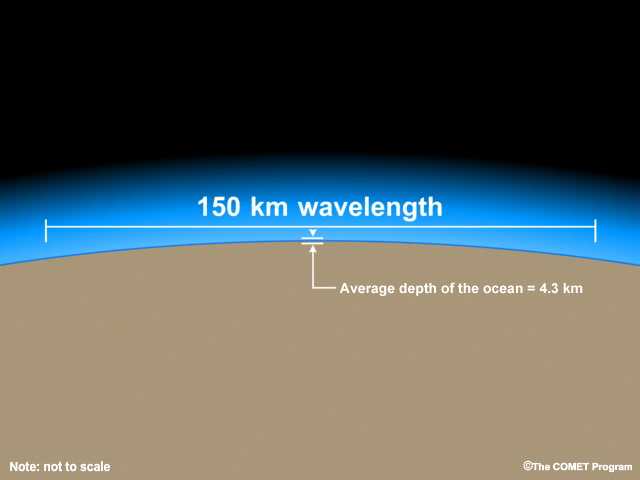
Now, let's further compare the wavelengths of wind waves and tsunami waves.
Tsunami wavelengths are commonly 100 to 500 kilometers. By contrast, the biggest wind waves might have wavelengths of around 100 to 200 meters. Now answer the following question, remembering that there are 1000 meters in a kilometer.
Question
How much bigger is a 150-km tsunami wavelength than a 100-m wind wave wavelength? Remember that 1 km = 1000 m. (Choose the best answer.)
The correct answer is d), 1500 times bigger. (150 km = 150,000 m. 150,000 m/100 m = 1500)
The Speed of Tsunamis
Now let's use the wave speed equation to explore something fascinating about tsunamis. Using the characteristics about wind waves and tsunami waves we learned previously, let's look at how they differ in speed. In the calculator on this page, first enter in the data about a typical wind wave and note the wave speed that results. Then enter the data about a typical tsunami.
The Tsunami Speed Calculator is currently in the process of being converted from Adobe Flash to HTML5, and therefore is currently unavailable.
Please check back at a future date, and proceed to the next page.
Would you have believed that tsunamis can travel as fast as a jet airplane?
Tsunamis at Sea
Question
What do you think a boat floating in the middle of the ocean experiences when a tsunami travels toward it at 800 km/h (500 mph)? (Choose the best answer.)
The correct answer is e).
Surprisingly, even at the speed of a jet, most tsunamis at sea are hardly felt by boats. The reason is that they have a very small wave height, often much less than a meter, and a very long wave period. This means the slope of the wave is very gentle, hardly noticeable at sea. It may take up to an hour to rise and fall from trough to trough. So why can tsunamis cause so much destruction on shore? Let's explore that next.
Wave Types
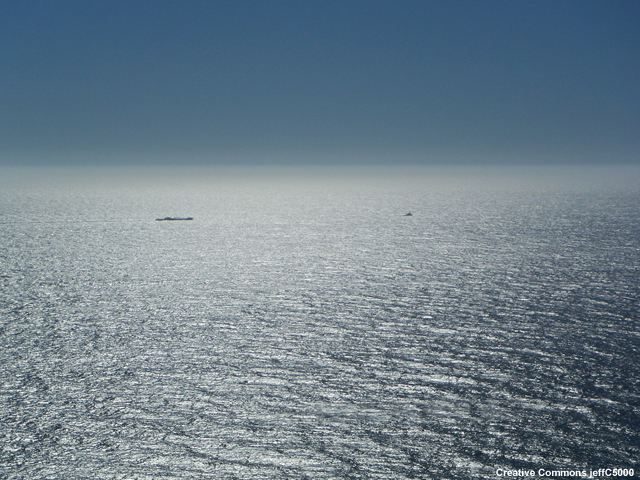
When most waves travel through the deep sea, they don't change very much along the way. Even if they travel thousands of kilometers from a distant storm, they may still have the same wave height and wavelength as they did when they were formed.
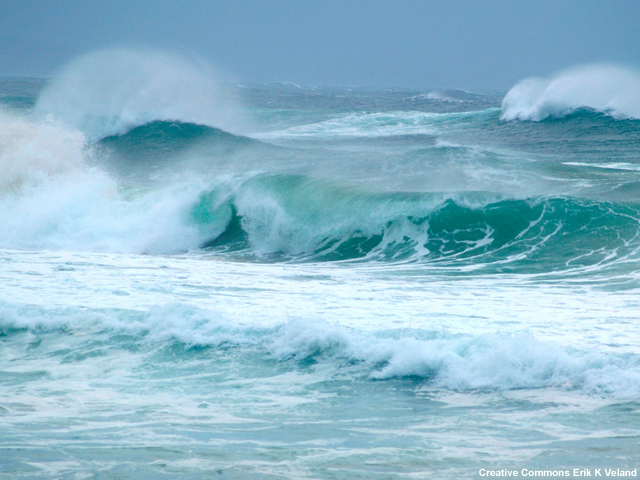
But when waves approach coastlines and begin to rush up onto the shore, they change dramatically. The rest of this lesson explores the difference between deep water and shallow water waves.
Deep and Shallow Water Waves
When wind creates waves at sea, these waves are called "deep water waves." Within a short distance from the surface, a deep water wave no longer affects the water underneath at all. The depth in which the wave is felt is equal to only one-half its wavelength. For this reason, even during a fierce storm the water is typically calm below about 150 meters. The bottom of the ocean is completely unaffected by deep-water waves.
When these same waves approach shore, however, they eventually become "shallow water waves." Once waves reach areas where the sea bottom is less than their wave depth, they begin a transformation. Shallow water waves are those in which the water depth is less than one-twentieth of their wavelength. Another way to say this is that the depth to wavelength ratio is less than 1/20. In the shallower water, the waves "feel" the bottom. That is, the water particles that orbit within them begin to interact with the bottom, which causes the wave properties to change. How might these changes affect the wave?
Properties of Shallow Water Waves
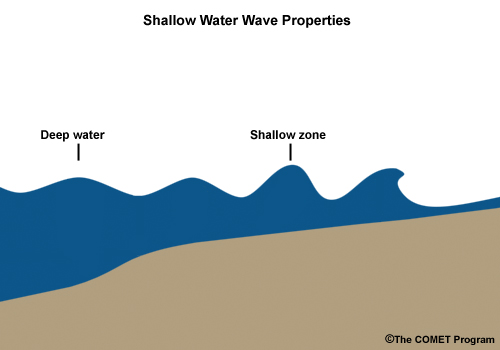
As waves enter shallower water, they do three things. First, they slow down as the water depth decreases; second, their wavelength decreases; and third, their wave height increases. Eventually, the wave height becomes so unstable that they often "break," sometimes causing the classic curl sought after by surfers.
You can think of this change as squeezing the wave, and because the wave loses only a little of its energy to friction, the wave has to grow higher when its wavelength decreases.
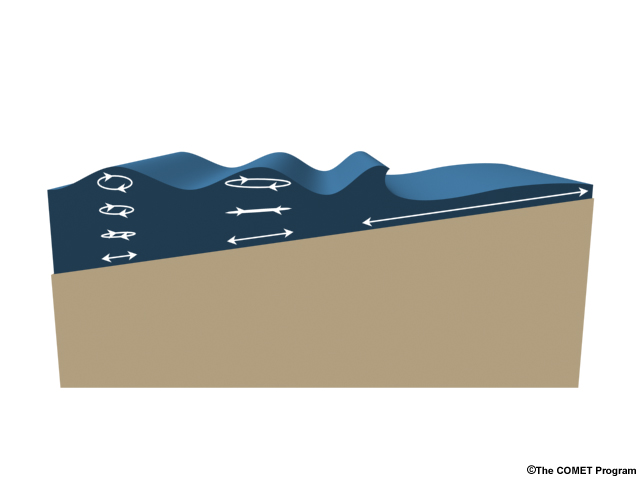
In addition to squeezing, as waves enter shallower water the circular paths of the water particles beneath them become flattened until the water is moving completely horizontally, rushing forward like a current. The bigger the wave, the stronger the current.
Tsunamis and Wave Type
The ocean averages 4.3 kilometers deep, and reaches depths of around 10 kilometers only in the deepest trenches. Tsunami wavelengths are commonly 100 to 500 kilometers. So what type of wave is a tsunami in the deep sea?
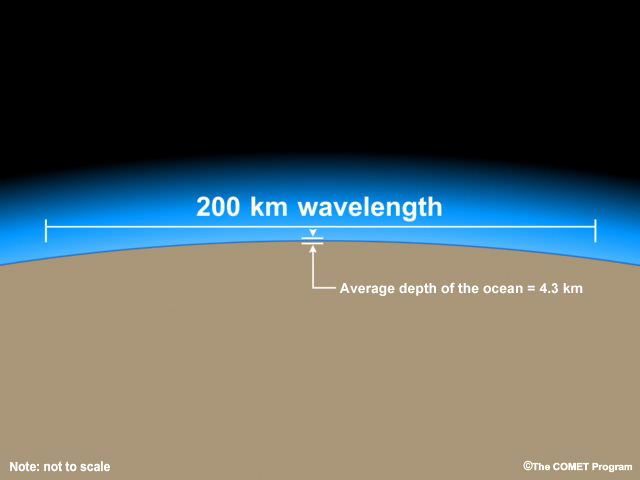
Question
Let's calculate the depth to wavelength ratio for a tsunami having a wavelength of approximately 200 km for an ocean depth of 5 km.
Divide depth by wavelength to discover the answer. Remember that if d/L <= 1/20, the wave is a shallow water wave. Based on this number, what kind of wave is a tsunami? (Choose the best answer.)
The correct answer is b).
Dividing 5 km/200 km = 1/40. 1/40 is less than 1/20, so a tsunami is a shallow water wave.
A little division shows you that tsunamis are actually "shallow-water waves." It seems strange that such big waves in the deep ocean could be called "shallow water waves," but their extremely long wavelengths give them this classification.
Tsunamis at Shore
Now, imagine what happens when a tsunami reaches the coast of a continent, and the depth of the sea goes from five kilometers to one meter, and even less. As you can imagine, a tsunami wave that is one meter high at sea can quickly become 30 meters high at the shore as the wave is "squeezed" and its height increases.
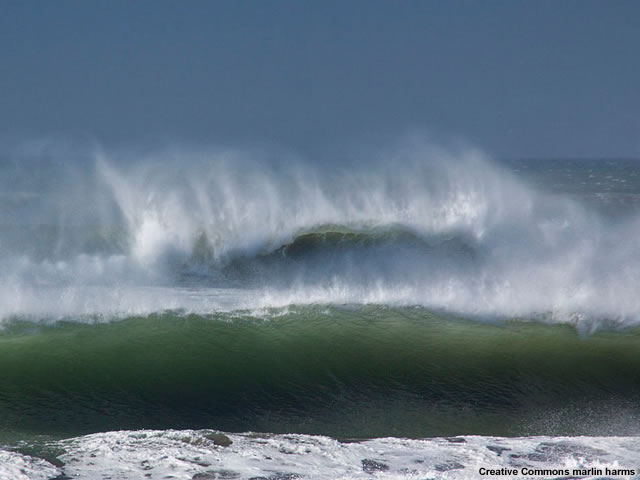
But because the wavelength remains relatively large, a tsunami almost never becomes steep enough to curl and break like suicidal surfers might wish. In fact, a tsunami wave may appear more like a fast rising tide as it approaches the shore.
As the water begins to move horizontally like a current at the shore, the tsunami wave slows down from over 800 km/h (500 mph) to something closer to 48 km/h (30 mph)—still fast enough to easily outrun people and push far inland over low-lying areas and up streams and rivers.
Summary
Light, sound, and water all travel in waves. Waves have crests and troughs. The wave height is the vertical distance between the top of a crest and the bottom of the adjacent trough.
A wavelength is the horizontal distance between two adjacent crests or troughs. The wave period is the time it takes a complete wave (from trough to trough) to pass a point.
Wavelength divided by wave period equals the wave speed.
Tsunamis typically have wavelengths of 100 to 500 kilometers, while large wind waves have wavelengths of around 100 to 200 meters. Tsunami speeds can reach 800 km/h or 500 mph, more than 30 times faster than a typical wind wave speed.
Deep water waves affect the water beneath them only for a short distance. Below about one half their wavelength, the water is typically calm.
Shallow water waves affect water all the way to the bottom because they have wavelengths much greater than the water depth. Even in the deep ocean, tsunamis are shallow water waves.
As waves near shore and water depth decreases, their wavelength decreases and wave height increases, as if the wave is squeezed and grows taller. Wave speed slows, but tsunamis at shore can still move fast enough to outrun people and push far inland and up rivers.
Click here to return to the 3.5 Hours Page.
